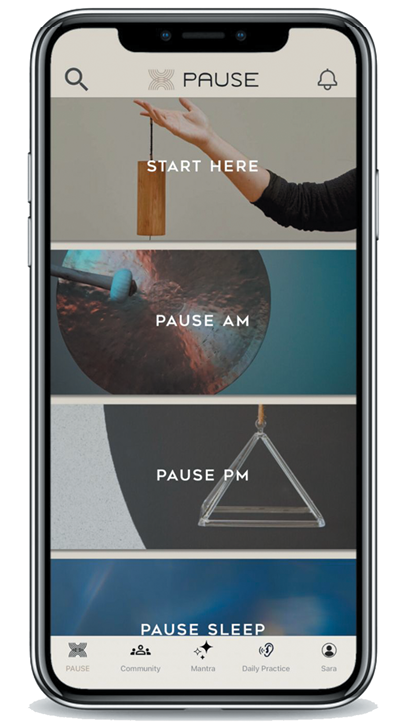- Home
- Media Kit
- MediaJet
- Current Issue
- Past Issues
- Ad Specs-Submission
- Reprints (PDF)
- Photo Specifications (PDF)
- Contact Us
- PRIVACY POLICY
- TERMS OF USE
![]()
ONLINE
![]()
ONLINE


Sara Auster
Sound Therapy
Editors’ Note
Sara Auster (saraauster.com) is a world-renowned sound therapist, meditation teacher, author, and creator of the PAUSE app. Her thoughtfully crafted experiences harness sound as a tool to support self-inquiry, cultivate deep relaxation, and inspire meaningful transformation. As a leading voice in her field, she creates welcoming spaces that expand the reach of meditation and sound baths – keeping accessibility and purpose at the forefront. From developing a mindfulness curriculum for the World Health Organization and creating FDA-approved sound baths as a complementary treatment option for people living with migraines, to partnering with organizations such as Apple, Spotify, Google, and MoMA to create inclusive sound bath experiences, she continues to be a pioneer in this space. Through her original methodology, the Auster Sound Method, she explores how listening transforms space – both physically and psychologically – and invites new audiences into deeper ways of being, shaping the future of healing for all.
Will you discuss your life journey?
My journey into sound therapy began with a personal healing experience. I was a musician and artist, but a serious accident led me to explore alternative healing modalities. During my recovery, I discovered how sound and deep listening could profoundly impact my physical, mental, and emotional well-being. This realization set me on a path to study meditation, sound therapy, and mindfulness, leading me to share this practice with others in an accessible and meaningful way.

The PAUSE app
What was your vision for creating Auster Sound, and how do you define its mission?
Auster Sound was born from a desire to make sound meditation and deep listening available to as many people as possible. My vision was to create experiences that help people feel more connected – to themselves, to others, and to their environments. The mission is simple yet profound: to use sound as a bridge to greater awareness, relaxation, and transformation.
How does listening transform space, both physically and psychologically?
Listening is a deeply transformative act. Physically, sound vibrations interact with our bodies, shifting our nervous system into a state of relaxation and receptivity. Psychologically, listening with intention can alter our perception of space, time, and emotion. A space that may feel chaotic can become a sanctuary simply through mindful listening. Sound can soften edges, create a sense of spaciousness, and foster a profound inner stillness.
What is a sound bath, and how do sound baths facilitate healing?
A sound bath is an immersive listening experience where participants are “bathed” in sound waves from instruments such as crystal singing bowls, gongs, and chimes. The vibrations help shift brainwave states, encouraging deep relaxation, stress reduction, and even emotional release. Sound baths facilitate healing by guiding the body into a parasympathetic state, allowing for restoration on a physical, mental, and energetic level.
Will you highlight the purpose of the PAUSE app?
PAUSE was created to make the practice of deep listening and mindfulness through sound more accessible. It offers guided sound experiences that help users integrate moments of stillness and self-care into their daily lives. Whether you need a few minutes to reset or a longer session to unwind, the app provides an opportunity to engage with sound as a tool for relaxation and self-inquiry.
What interested you in writing the book, Sound Bath: Meditate, Heal and Connect Through Listening, and what are the key messages you wanted to convey in the book?
I wrote Sound Bath to offer a practical and approachable guide to sound therapy and meditation. I wanted to empower people with the tools to explore sound in their own way, whether through listening, creating, or simply being more present with the sounds around them. The key messages are that sound is a universal and accessible healing modality, that listening is a transformative practice, and that anyone can incorporate sound into their daily lives for greater well-being.
Your work has impacted many lives. Are you able to take moments to reflect on what you have accomplished?
I try to, though it’s not always easy. My work is about being present, so I remind myself to take in those moments when I see the impact of sound on someone’s face, hear a story of transformation, or feel the collective energy in a room shift. It’s deeply fulfilling to witness how sound can bring people into connection with themselves and others. Those moments of reflection remind me why I continue this work. ![]()